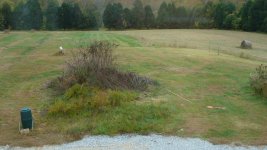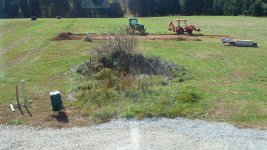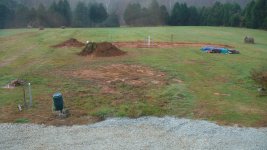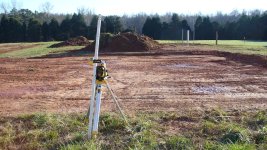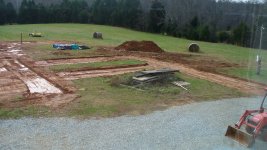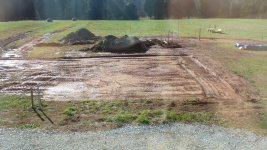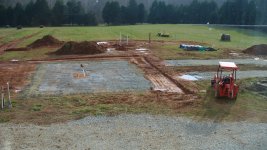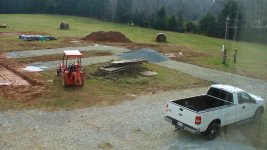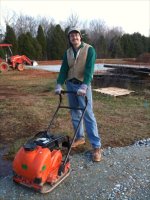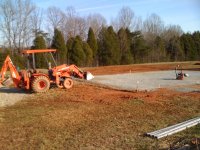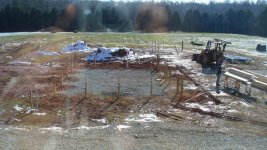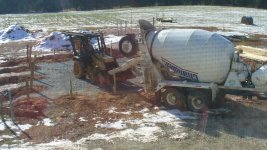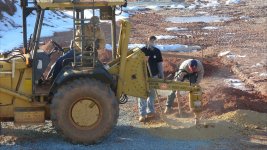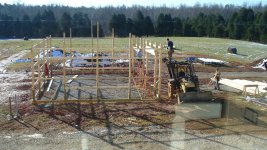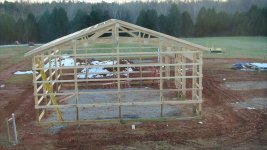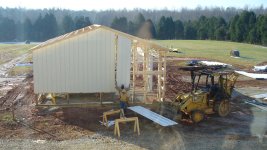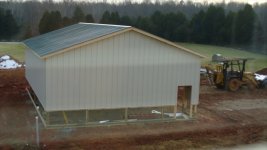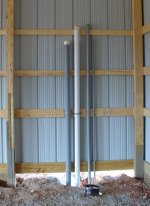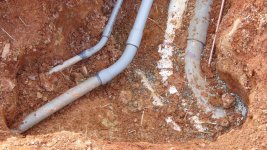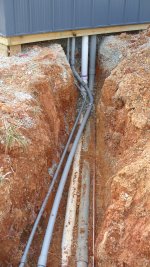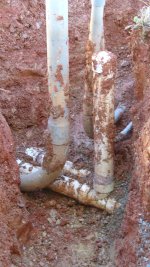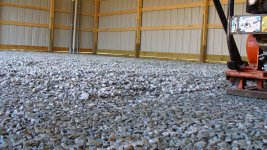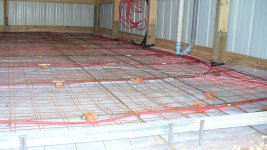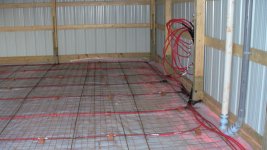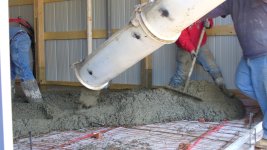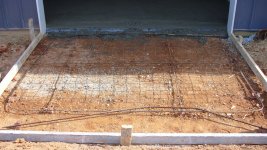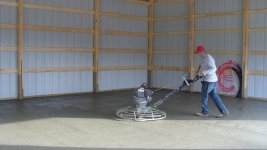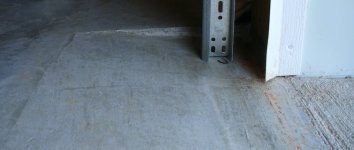eepete
Platinum Member
Here's a bunch of posts that show how a new tractor garage went together.
One common theme in this project is this: This is a Tractor Garage. It is not a shop. I'll do a lot of little servicing items here including fluid changes and small repairs. But I don't expect to do a lot of major repair or design work. That decision affects a lot of choices that were made. I consider a garage to be much cheaper than a shop. A shop would cost as much as a house per square foot, and would have a main room, dirty room (for welding), a paint area, bathroom, and some storage. A garage lets you park vehicles and do minor work on them.
The area where the garage will go is south of the house. This is also where the garage on the house is. I have my electronics shop above the garage, and through a window have a good view of the entire site. The 1st picture shows the site, complete with left over top soil pile from construction of the house (which finished in late 2007).
It is clear that I'll need to do a little earth moving on this job. I got a new tractor in the fall of 2009, which is part of why I needed a garage. What a great problem to have! It's a JD 4520 (60 HP, hydro, 50HP PTO, CAB). I've had a Kubota B21 since 1997 and love it. Clearly these two colors work well together. WhenI got a ball park quote on some of the grading cost (both clearing, leveling, and final grading) it was close to the cost of a box blade. No brainer there, the 2nd picture shows which way I went :thumbsup: !
Another project was started before this- it's a photovoltaic power system (aka solar cells). This will be a grid tie inverter system, about 8KW DC, 6KW AC. I started this project before I had a firm date on when the building would show up. So the area in the 3rd picture is where the solar panels will go. I've scraped the top soil off for my 1st project with the box blade. Note also the conduit and 4x4 post in the lower left of the picture. These are pipes that go into the basement of the house so that when I got around to building a tractor garage, I could get back to the house. I also ran conduit out to where the PV array will go, you can see a drywall bucket on that. On the right, you see lumber that has been delivered for a small shed that will house the inverter for the PV project.
I got a lot done one the PV project before this- you can see conduit pipes sticking up. All the trench work, ground wires, and conduit for the solar project are in. When that project is done, I'll post that project.
The building will be a Morton County Craft 30' x 40'. There is a build date of December 1st, so it's time to get the site ready. The building will go right where the top soil pile is, so the 1st order of business is to move that. It will be just behind/south of the new garage. Seems like there is no more pure form of seat time that moving a pile of something with a FEL.
One common theme in this project is this: This is a Tractor Garage. It is not a shop. I'll do a lot of little servicing items here including fluid changes and small repairs. But I don't expect to do a lot of major repair or design work. That decision affects a lot of choices that were made. I consider a garage to be much cheaper than a shop. A shop would cost as much as a house per square foot, and would have a main room, dirty room (for welding), a paint area, bathroom, and some storage. A garage lets you park vehicles and do minor work on them.
The area where the garage will go is south of the house. This is also where the garage on the house is. I have my electronics shop above the garage, and through a window have a good view of the entire site. The 1st picture shows the site, complete with left over top soil pile from construction of the house (which finished in late 2007).
It is clear that I'll need to do a little earth moving on this job. I got a new tractor in the fall of 2009, which is part of why I needed a garage. What a great problem to have! It's a JD 4520 (60 HP, hydro, 50HP PTO, CAB). I've had a Kubota B21 since 1997 and love it. Clearly these two colors work well together. WhenI got a ball park quote on some of the grading cost (both clearing, leveling, and final grading) it was close to the cost of a box blade. No brainer there, the 2nd picture shows which way I went :thumbsup: !
Another project was started before this- it's a photovoltaic power system (aka solar cells). This will be a grid tie inverter system, about 8KW DC, 6KW AC. I started this project before I had a firm date on when the building would show up. So the area in the 3rd picture is where the solar panels will go. I've scraped the top soil off for my 1st project with the box blade. Note also the conduit and 4x4 post in the lower left of the picture. These are pipes that go into the basement of the house so that when I got around to building a tractor garage, I could get back to the house. I also ran conduit out to where the PV array will go, you can see a drywall bucket on that. On the right, you see lumber that has been delivered for a small shed that will house the inverter for the PV project.
I got a lot done one the PV project before this- you can see conduit pipes sticking up. All the trench work, ground wires, and conduit for the solar project are in. When that project is done, I'll post that project.
The building will be a Morton County Craft 30' x 40'. There is a build date of December 1st, so it's time to get the site ready. The building will go right where the top soil pile is, so the 1st order of business is to move that. It will be just behind/south of the new garage. Seems like there is no more pure form of seat time that moving a pile of something with a FEL.
Attachments
Last edited:
